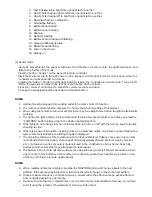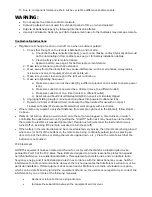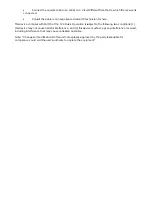
D.
Due to component tolerances, there will be cycle time differences between sets.
WARNING:
•
Do not expose the remote control to moisture.
•
Remove battery when not used for extended period of time, or when depleted.
•
Dispose of batteries properly by following directions on batteries.
•
Use only 12V Alkaline battery type 23A for replacement, use of other batteries may damage remote.
Troubleshooting Instructions:
•
If lights do not change function or turn off or on when a button is pushed:
1.
Check that the light on the remote is illuminating and not dim:
a.
Check that battery is inserted properly (+ and -) and making contact (typically LED would
not be illuminating in this condition), see page 1 for battery installation details.
b.
Clean battery and remote terminals.
c.
Replace battery, see page 1 for battery replacement details.
2.
Make sure antenna is up and fully extended.
3.
Move away from other items that may cause interference, such as cell phones, 2-way radios,
microwave ovens, computers, Wi-Fi access points, etc.
4.
Make sure you are close enough to the light set control box.
5.
Make sure light string has power:
a.
Make sure power is on at the outlet (try a different product on the outlet to ensure power
is on)
b.
Make sure outlet is not powered by a dimmer (move to a different outlet)
c.
Make sure outlet is not on a timer (more to a different outlet)
d.
Reset Ground Fault Circuit Interrupter (GFCI) in case it accidentally tripped.
6.
Unplug light string plug for 1 minute and plug back into powered outlet and retry.
7.
If used on a timer controlled circuit, make sure the timer is rated for use with Compact
Fluorescent bulbs (CFL) as some timers will not work properly with electronics.
•
If the remote only works at a very short distance (for example, right next to the light set), follow steps 1 –
3 above.
•
If sets do not turn on when power is turned on to the set (when plugged in, timer turns on, or switch
controlling the outlet is turned on), try pushing the “On/Off” button as it may have been turned off via
the remote the last time it was used (remember, this product will remember the last function it was
turned off at, including if the remote was used to turn the set off).
•
If the battery in the remote drains and becomes depleted very quickly, then the remote is being placed
where one (or both) of the buttons on the remote are being continually pushed (such as placing an
item on top of the buttons, or storing the remote upside down, etc.). Place the remote such that the
buttons are not pushed.
FCC Statement
NOTE: This equipment has been tested and found to comply with the limits for a Class B digital device,
pursuant to Part 15 of the FCC Rules. These limits are designed to provide reasonable protection against
harmful interference in a residential installation. This equipment generates, uses, and can radiate radio
frequency energy, and if not installed and used in accordance with the instructions, may cause harmful
interference to radio communications. However, there is no guarantee that interference will not occur in a
particular installation. If this equipment does cause harmful interference to radio or television reception,
which can be determined by turning the equipment off and on, the user is encouraged to try to correct the
interference by one or more of the following measures:
•
Reorient or relocate the receiving antenna.
•
Increase the separation between the equipment and receiver.






















